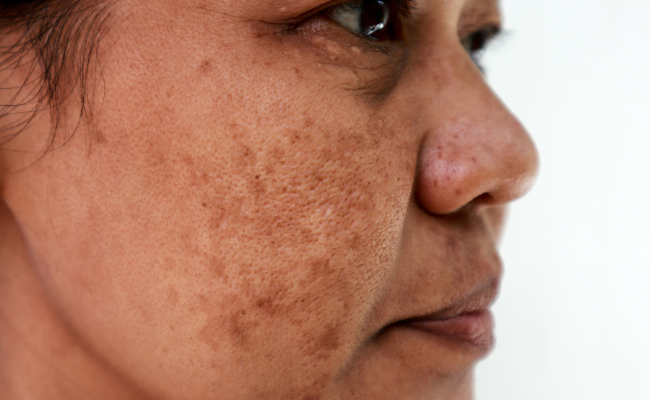How to Treat Melasma?
- November 16, 2023
- No Comments

What is Melasma?
Melasma, identified by the emergence of brown or gray-brown patches on facial regions like the cheeks, forehead, nose bridge, and upper lip, stems from an excess production of melanin—the pigment governing skin color. While this hyperpigmentation is harmless and poses no health threat, its impact on one's appearance can significantly influence self-esteem. Often termed the "mask of pregnancy," melasma, presenting as light to dark brown or blue-gray patches resembling flat patches or freckle-like spots, tends to affect not only the face but also areas like the forearms. Referred to as chloasma on occasion, this benign condition may trigger self-conscious feelings. Characterized by a distinctive pattern of darkening and lightening, melasma intensifies during the summer and alleviates in the winter, further underscoring the fluctuating nature of this skin condition.
Why Does Melasma Occur?
The precise cause of melasma remains elusive, but several factors contribute to its development. Exposure to ultraviolet (UV) light is a known trigger, as UV rays stimulate the melanocytes, the pigment-producing cells in the skin, leading to an increased production of melanin. Hormonal changes also play a significant role in melasma, with women being more commonly affected. Pregnancy, birth control pills, and hormone replacement therapy can induce hormonal fluctuations that contribute to the onset of melasma, earning it the colloquial term "the mask of pregnancy." Additionally, there is a genetic predisposition to melasma, with a family history of the condition increasing the likelihood of its occurrence.
How is Melasma Diagnosed?
Diagnosing melasma primarily involves a visual examination by a dermatologist. The distinctive brown or gray-brown patches on the face are usually sufficient for diagnosis. In some cases, a Wood's lamp, which uses ultraviolet light, may be employed to assess the extent of pigmentation. A thorough medical history is essential, as it helps identify any hormonal changes or medication use that may be contributing to melasma.
Treatment Solutions for Melasma
- Hydroquinone: A widely used skin-lightening agent, hydroquinone works by inhibiting the production of melanin. It is often a key component in many melasma treatments and is available in various strengths.
- Tretinoin and Corticosteroids: These topical treatments may be prescribed in conjunction with hydroquinone to enhance its effectiveness. Tretinoin helps with cell turnover, while corticosteroids reduce inflammation.
- Azelaic Acid: Another option for topical treatment, azelaic acid helps control melanin production and has anti-inflammatory properties.
- Glycolic Acid and Trichloroacetic Acid (TCA): Chemical peels are procedures where a chemical solution is applied to the skin, causing it to exfoliate and eventually peel off. This process helps reduce pigmentation and can improve the appearance of melasma. The depth of the peel is determined by the type and concentration of the chemical used.
- Intense Pulsed Light (IPL) and Fraxel Lasers: Laser treatments target pigmented areas of the skin, breaking down excess melanin and stimulating collagen production. These procedures should be performed by experienced dermatologists or skincare professionals to ensure safety and efficacy.
- Microdermabrasion: Microdermabrasion is a less invasive procedure that involves using a device to exfoliate the outer layer of the skin. While it may not be as effective as some other treatments, it can still contribute to a reduction in pigmentation.
- Cosmetic Camouflage: Specialized makeup designed to conceal pigmentation irregularities can provide a temporary solution for individuals seeking immediate improvement in the appearance of melasma.
- Sun Protection: One of the fundamental aspects of melasma management is sun protection. Exposure to UV rays can exacerbate pigmentation, so using broad-spectrum sunscreen with a high SPF, wearing protective clothing, and avoiding prolonged sun exposure are crucial preventive measures.
Benefits of Melasma Treatment
- Improved Skin Appearance: Perhaps the most tangible benefit of melasma treatment is the improvement in the skin's appearance. Reduction in hyperpigmentation leads to a more even skin tone, contributing to a healthier and more youthful look.
- Boosted Confidence: Melasma can be emotionally distressing due to its visible nature. Successful treatment can significantly boost an individual's confidence and self-esteem as they witness positive changes in their skin.
- Prevention of Worsening: Early intervention and consistent sun protection are key to preventing the worsening of melasma. Timely treatment can reduce the risk of additional pigmentation and complications.
- Personalized Approach: Dermatologists tailor treatment plans to the specific needs of each individual. Factors such as skin type, the severity of melasma, and any underlying causes are considered to ensure a personalized and effective approach.
- Long-Term Management: Certain treatment modalities, such as sun protection and the use of topical agents, contribute to the long-term management of melasma. This reduces the likelihood of recurrence and helps individuals maintain healthy skin over time.
- Minimized Discomfort: Melasma can cause emotional discomfort, especially when the visible effects are prominent. Successful treatment minimizes this discomfort, contributing to an overall improvement in well-being.
Comments (0)